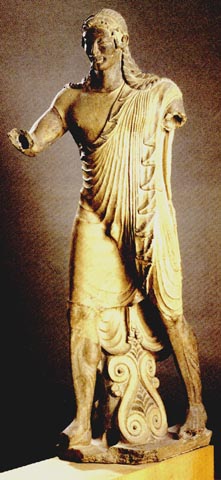Our first stop was a museum in Tarquinia, at which we could sadly not take photos. It was filled with ancient Etruscan stuff, the Etruscans being the people who lived near
Laris Pulena: The very picture of a 'fat and happy' Etruscan.
We also saw a lot of early burial stuff, like biconical urns for ashes (some of them had helmets at the top part of the urn) or hut shaped urns, as homes for the dead. I had seen photos of them before, but what struck me was how large they were. You can’t really tell with just a photo in a classroom that the hut urn is about a foot wide.
okay so this is a drawing, but you get the idea.
We didn’t really have a lot of time in the museum, because you really could spend many hours there. We had about one. I got to see lots of terracotta sculptures and stuff carved out of stone, and some cool other stuff like a reconstruction of a tomb with painted walls.
But wait.. our next stop was the location of the real thing! The painted tombs were all behind glass sealed doors so you could see in, but the climate wouldn’t affect the ancient paintings and cause them to deteriorate. For that reason, I don’t really have photos of that either. But the countryside around the hill where this was is amazing:
Also, these stone basin things were what used to contain the ash urns.
After our terribly British narrator gave us the tour of the painted tombs and lunch, we were off to Banditaccia, the necropolis of Old Caere (Cerveteri). This was extremely cool. The city of the dead was completely open to our access, meaning we could climb on it and into the tombs themselves.
They're even decorated with stripes.
The giant mounds are called tumuli, and there are family “homes” carved into the very rock underneath. Often there are several rooms in one ‘home’ and can even been several ‘homes’ in one earth mound, presumably extended family members in the same hill. Other tombs were just cut separately square into the hillside like “condos” our professor said. All in all, it felt very adventurous to be scurrying up and down the paths in the sprawling city filled with chambers cut right from the rock. We were divided into groups, so here’s me with mine inside one of the tombs:
We, raiders of tombs
Our bus stopped at the beach so we could relax for a few before heading back to the centro.
Black volcanic sand.
With barely a breather of one day in between (used for reading, Greek, Latin, and Italian for us centristi).. we were off again this morning headed for
Foundations only.
The reason being, all the goods from all the places like Ceveteri and the temple had been moved off to museums all over the place, and our next stop was the Villa Giulia, which houses a good many of them. No photos, again, except in the courtyard, but rows upon rows of Greek vases (imports from back in the day), bronze work, pieces of temples, and of course the lovely terra cottas from Veii. This is what the Apollo looks like:
He is similar in style to the famous couple sarcophagus which was also in the museum:
Etruscans.
The museum also had the three gold tablets from Pyrgi which have inscriptions in Phonecian and in Etruscan. No one can reeallly read Etruscan, so these tablets are kind of a big deal in the language department. I thought, once again based on photos in class back at Vandy that I’d seen, that they were huge. They’re actually like eight inches tall each, maybe. I have photos of these, but they are saved in the wrong format (from class last year).
After that, we went to see a piece of one of Rome’s oldest walls, called the “Servian” wall after one of the kings of Rome (pre-Republic, and pre-empire) from around 600BC (so it’s claimed, but the materials are more like 400 BC).
Yeah ancient walls made of tufa blocks.
So far.. that’s all. But it’s all so, so cool!











1 comment:
Very cool. Even cooler with photos and enthusiasm thrown in. ;-)
Post a Comment